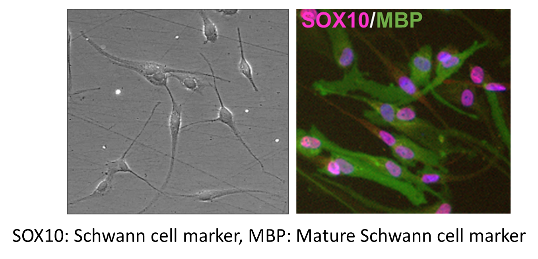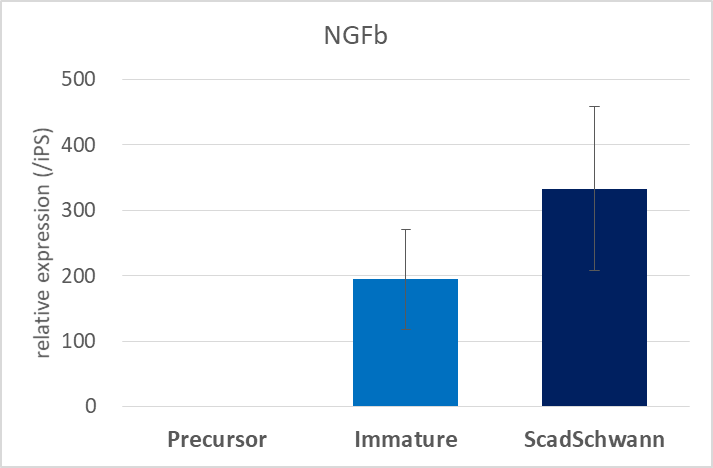Never miss an update from Larisa Sheloukhova
Create your free account to connect with Larisa Sheloukhova and thousands of other innovative organizations and professionals worldwide
There are many types of nerve injuries awaiting new advanced therapies. One example is entrapment neuropathy, a group of injuries caused mainly by compression of peripheral nerves, resulting in numbness, pain, sensory disturbance, and muscle weakness, which significantly impair patients’ daily lives. Carpal tunnel syndrome, the most common entrapment neuropathy, is reported with 1 - 5% incidence worldwide, but there is no treatment other than surgery, which is not effective in many cases. In addition, there are many traumas resulting in peripheral nerve rupture or spinal cord injury leading to irreversible limb loss or systemic dysfunction, respectively. There is no treatment for these nerve injuries except for surgery, which is often ineffective due to limited nerve regeneration.
Cell therapies are under development, particularly for spinal cord injuries, with very limited success so far and/or in early phases. Schwann cells are a type of nerve system cells that play important roles in repair, regeneration, and growth of peripheral nerves. Although therapy using autologous Schwann cells for spinal cord injury has been reported, harvesting from one’s neural tissues poses challenges due to cell number limitation and damage to intact nerves. Thus, mass production of allogeneic Schwann cells is a better alternative, but it has been difficult to develop. SCAD is a spin-off from Kyoto University, which has successfully achieved the production of Schwann cells using pluripotent stem (PS) cells, including ES and iPS cell lines, and is now developing cell therapy for neuropathies and nerve injuries.
Technical Summary
SCADscientists have succeeded in stable mass production of research-grade Schwann cells from iPS cells. These iPS cell-derived SCAD Schwann cells (ScadSchwann) exhibit high maturity, as evidenced by high-level expression of SOX10 and MBP, Schwann cell maturation markers (Fig.1). ScadSchwann also show high production of NGFβ, which is the most important neurotrophic factor for axon regeneration (Fig.2). Additionally, ScadSchwann stably produce laminins, which serve as scaffolds for axonal regeneration, as well as CCL2 chemokine, which mobilizes macrophages to remove damaged fragments. These data indicate ScadSchwann’s potential for therapeutic applications for nerve regeneration.
Figure 1. Production of matured Schwann cells


Figure 2. NGFβgene expression

Fornon-clinical proof of concept, SCAD in collaboration with Kyoto University Medical School transplanted their Schwann cells into peripheral nerve in a clinically relevant animal model of entrapment neuropathy and nerve injury. The results suggest clinical efficacy, as evidenced by improvements in pathology and electrophysiology, as well as in sensory and motor functions. Based on these research findings, SCAD plans to develop ScadSchwann cell therapy for nerve injuries to promote nerve axon regeneration. Such conditions as carpal tunnel syndrome, peripheral nerve injury, spinal cord injury, and Charcot-Marie-Tooth Disease type 1 (CMT1) are among the potential targeted indications. To achieve this, SCAD is set to establish mass production of PS cell-derived Schwann cells, ensuring enough number of cells needed for each patient and reducing manufacturing costs. This will ensure ready-to-use stocks of allogeneic Schwann cells stored at medical institutions, which is impossible to achieve using autologous cell therapy.
Clinical KOLs of Kyoto University and SCAD are going to launch a clinical trial for carpal tunnel syndrome and/or nerve injury as the initial indications. Ongoing efforts include the development of the clinical-grade ScadSchwann, such as the selection of clinically suitable PS cell lines through collaboration with Kyoto University, as well as optimization of the production process and quality testing.
SCAD is actively seeking collaborators and strategic business partners to aid in the development of clinical cell therapy for patients utilizing allogenic PS cell-derived Schwann cells, to launch clinical trials.
Technology Readiness Level
3
Production method of PS cell-derived Schwann cells
Mechanisms of Action
Preclinical POC
Potential Applications
Carpal tunnel syndrome
Spinal cord injury
Peripheral nerve injury
CMT1
Possible Collaboration Mode(s)
R&D collaboration
Licensing
Business and/or Investment Partnership
Patent No
Patent pending
(the production method for pluripotent stem cell-derived Schwann cells)
Inventor(s)
Norio Nakatsuji, Ph.D., Emeritus Prof. Kyoto U.
Koichi Igura, Ph.D.
Norie Tooi
Kyoto University was founded in 1897, the second university to be established in Japan. Kyoto University is among 10 National Designated Universities in Japan. It boasts 18 graduate schools, 10 faculties, 12 research institutes, and 26 centers and other establishments. Research conducted at Kyoto University spans the full spectrum of fields from social to natural science.
The outstanding research conducted at Kyoto University gives birth to useful technologies that could greatly benefit society. IAC (Office of Institutional Advancement and Communications) was established at Kyoto University to bridge the gap between researchers and industry. We facilitate joint research, technology transfer, creation of university startups, and provide entrepreneurial education. We are building a strong network of global industry partners to make sure basic research reaches the market.
Create your free account to connect with Larisa Sheloukhova and thousands of other innovative organizations and professionals worldwide
Send a request for information
to Larisa
Technology Offers on Innoget are directly posted
and managed by its members as well as evaluation of requests for information. Innoget is the trusted open innovation and science network aimed at directly connect industry needs with professionals online.
Need help requesting additional information or have questions regarding this Technology Offer?
Contact Innoget support